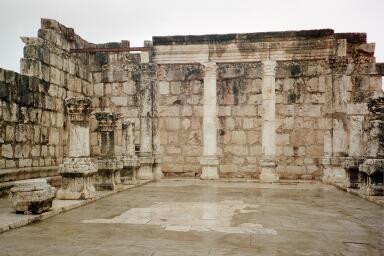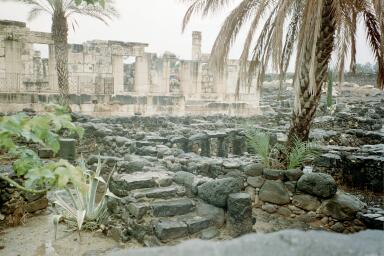Capernaum - Miracles of Grace
Reading: Mark 2.1-12
Hebrew is the official language in Israel, but mostly you can get by well enough with English. Street and road signs have English as well as Hebrew, in some areas with Arabic too.
You have to think laterally at times, because the English rendering isn’t always consistent – and it may not follow our "traditional" spelling. So you can be following road signs to "Jerusalem", but come across a sign to "Jerushalayim" – same place. Or you are on your way to "Masada", but the turn-off from the Dead Sea highway reads "Mezzada." The person doing the road sign doesn’t consult other English road signs but decides on his own translation!
So too when we were heading to "Capernaum" and the final road sign said, "Kfar Nahum." That means "village of Nahum" – though not a reference to the Old Testament prophet of that name.
 Capernaum comes in for no special mention in the Old Testament, though it was an important city on the north-west shore of the Sea of Galilee by the time of Christ. There was probably a Roman military post, since a centurion came to Jesus seeking healing for his servant (Matthew 8.5-13). It was in Capernaum that Matthew sat in his tax office when Jesus called him to follow (9.9ff).
Capernaum comes in for no special mention in the Old Testament, though it was an important city on the north-west shore of the Sea of Galilee by the time of Christ. There was probably a Roman military post, since a centurion came to Jesus seeking healing for his servant (Matthew 8.5-13). It was in Capernaum that Matthew sat in his tax office when Jesus called him to follow (9.9ff).
In Mark 1.21ff we read about Jesus healing a man in the synagogue at Capernaum on the sabbath day. The present ruined white synagogue was built on the foundation of a black basalt synagogue dating from Jesus’ time.
Not long afterward, Jesus was in Capernaum again. People crowded into a house and pressed around the door to hear him.
In the ruins of Capernaum the layout of streets and houses is clearly visible. Houses were built in groups of four around a central courtyard. The roofs and most of the walls have long since gone.
 The practice was to build a flat roof, accessible by steps from the outside. Families would go on the roof on hot nights, and, during the Festival of Booths, actually slept there. Roofs were constructed from beams covered with branches and a thick layer of mud plaster.
The practice was to build a flat roof, accessible by steps from the outside. Families would go on the roof on hot nights, and, during the Festival of Booths, actually slept there. Roofs were constructed from beams covered with branches and a thick layer of mud plaster.
Four men had carried their paralysed friend to Jesus, whose reputation as a healer had reached them. When they arrived at the house where Jesus was staying, they couldn’t get anywhere near Jesus. The room was packed and there was no room "even outside the door". The outer courtyard was packed as well.
So they carried their friend onto the roof and made a hole large enough to lower the man on his mat. That certainly got everyone’s attention. It doesn’t take much imagination to picture the scene from inside. The assembled crowd had come to hear Jesus. They were hanging onto his every word. There was a distracting noise above them. Then dust and bits of mud began to fall until the light of day started to shine into the room. They lowered their friend on his mat into the middle of the room in front of Jesus.
There were five conspicuous men – the man on the mat and the four gazing down through the hole. Those present looked down and looked up. The record tells us that, when Jesus saw their faith, he said to the paralytic, "Son, your sins are forgiven" (v. 5).
Whose faith? The sick man had presumably consented to be brought to Jesus. But whatever faith he had couldn’t have achieved his healing without the practical action of his four friends.
Perhaps the man had long since given up the hope of a return to good health. Sometimes it can seem easier to "accept" sickness – and to live on the goodwill and hand-outs of others.
Evidently, in this case, there were other reasons too. They aren’t spelled out for us – except that this man carried a hidden burden of guilt which needed to be resolved and forgiven if health was to be restored. Jesus didn’t subscribe to the popular view that there was a direct connection between sin and sickness (John 9.2). In this case, however, there had to be forgiveness before there could be healing.
And Jesus saw "their faith" – and both forgave and healed the man.
Again and again we are dealing with people who have no faith, or else, in spite of some sort of faith, have lost all hope. Faith is so personal, and yet we can believe for people – our confidence that Jesus can bring them help and hope.
Our faith will be expressed in both prayer and action. And the Lord will see our faith and bring his blessing to them. The completeness of that blessing will still depend on the stirring of their faith to receive the miracles of God’s grace. But our faith will be the seed that triggers their faith.
| PRAYER: Loving Lord, we believe in you, but don’t always know how to relate our faith to others in this unbelieving world. Sometimes we have to do with people for whom all courage and hope has gone. We think to ourselves, "If only…" for your help and hope are freely offered to all. Help us to believe for others, so that their faith will be stirred and your blessing received. In Jesus’ name, Amen.. |
Make Me New!
Healing?
Don’t bother me!
Across
these many years
all hope
is gone –
leave me alone!
God, you say?
Where’s he been
all these years?
Life
has been hard
to me
and I
have hardened
to it!
Jesus?
That name
has been
on my lips
countless times –
a name to bless,
you say,
and not to curse?
Jesus!
I’m here
at last!
Make me new!
© Peter J. Blackburn, Burdekin Blue Care Devotions, 7 August
2001
More photos of Israel are available here.
Except where otherwise noted, Scripture quotations
are from the New International Version, © International
Bible Society, 1984.
Back to Sermons
 Capernaum comes in for no special mention in the Old Testament, though it was an important city on the north-west shore of the Sea of Galilee by the time of Christ. There was probably a Roman military post, since a centurion came to Jesus seeking healing for his servant (Matthew 8.5-13). It was in Capernaum that Matthew sat in his tax office when Jesus called him to follow (9.9ff).
Capernaum comes in for no special mention in the Old Testament, though it was an important city on the north-west shore of the Sea of Galilee by the time of Christ. There was probably a Roman military post, since a centurion came to Jesus seeking healing for his servant (Matthew 8.5-13). It was in Capernaum that Matthew sat in his tax office when Jesus called him to follow (9.9ff). The practice was to build a flat roof, accessible by steps from the outside. Families would go on the roof on hot nights, and, during the Festival of Booths, actually slept there. Roofs were constructed from beams covered with branches and a thick layer of mud plaster.
The practice was to build a flat roof, accessible by steps from the outside. Families would go on the roof on hot nights, and, during the Festival of Booths, actually slept there. Roofs were constructed from beams covered with branches and a thick layer of mud plaster.